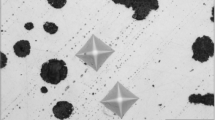Conclusion
After heat treatment cast iron changes both its mechanical and magnetic properties, which is connected with structural transformations in the matrix. Thus, from results of the change in magnetic properties for cast iron, it is possible to estimate the amount of heat treatment, i.e., to establish the structural and phase condition of the cast iron, and to estimate the completeness of transformations occurring during quenching and tempering.
As parameters for monitoring the heat treatment of HCSG and PMC in the tempering range 600–750°C, it is possible to use\(H_{\mu _{\max } } \) and µ300, and µ300 is to be preferred. In the range ttem=500–600°C\(H_{\mu _{\max } } \) should be used.
Results of these studies have been used in developing an electromagnetic structurescope by means of which measurements have been made of differential dynamic magnetic permeability for monitored and reference articles located in continuous eddy-current converters.
Test for a structurescope under production conditions at the Volga Automobile Factory during quality control of temper hardening for PMC and HCSG castings demonstrated its high efficiency, reliability and productivity.
Similar content being viewed by others
Additional information
Zaporozhe Automobile Factory "Kommunar." Zaporozhe Machine Building Institute. Translated from Metallovedenie i Termicheskaya Obrabotka Metallov, No. 6, pp. 10–11, June, 1987.
Rights and permissions
About this article
Cite this article
Minevich, A.S., Zhivitsa, I.V. & Shul'ge, G.Y. Mechanical and magnetic properties of cast irons VCh 50-2 and KCh 50-5 after temper hardening. Met Sci Heat Treat 29, 413–415 (1987). https://doi.org/10.1007/BF00715876
Issue Date:
DOI: https://doi.org/10.1007/BF00715876




